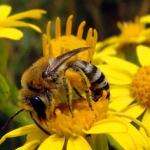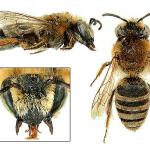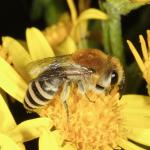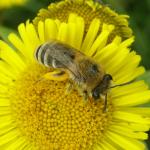Bees of the genus Colletes, in common with those of the genus Hylaeus, are readily identified by their short, bifid tongues. They look superficially similar to many of the Andrena bees. Some species specialise on pollen from a specific plant or closely related group of plants (oligolectic). Identification keys and general information are given in Guichard (1974).
Widespread in sandy districts in southern and central England and Wales, scarcer towards the north. There is only one record in Scotland. The species is absent from Ireland, but does occur in the Channel Islands (Alderney, Guernsey, Jersey). Widespread in Europe and Asia: Fennoscandia south to Spain, and east to Siberia.
This species is not regarded as being scarce or threatened.
Associated with meadows and edge habitats in sandy districts, including coastal dunes.
Univoltine; late July to early September.
Nothing is known about the nesting biology of this species, except that it nests in the ground.
Ragwort (Senecio jacobaea), tansy (Tanacetum vulgare), fleabane (Pulicaria dysenterica), yarrow (Achillea millefolium), creeping thistle (Cirsium arvense), mayweed (Matricaria spp.), hawk's beard (Crepis capillaris), bramble (Rubus fruticosus agg.), English stonecrop (Sedum anglicum), sea spurge (Euphorbia maritima), bell heather (Erica cinerea), bog pimpernel (Anagallis tenella) and sheep's-bit (Jasione montana).
Epeolus variegatus is recorded as a cleptoparasite (R C L Perkins 1920; Richards 1937). Epeolus cruciger may also be cleptoparasitic on this species (Richards 1937).





